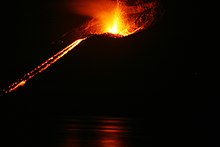Krakatoa
Krakatoa (Indonesian name: Krakatau) is an active volcano in the Sunda Strait, Indonesia. There are many different ways the name has been spelled. The volcano has erupted repeatedly in known history. The best known of these events occurred in late August 1883.
| Krakatoa | |
|---|---|
 An 1888 lithograph of the 1883 eruption of Krakatoa. | |
| Highest point | |
| Elevation | 813 m (2,667 ft) |
| Prominence | 813 m (2,667 ft) |
| Isolation | 21.71 km (13.49 mi) |
| Coordinates | 6°06′07″S 105°25′23″E / 6.102°S 105.423°E[1] |
| Geography | |
| Location | Indonesia |
| Geology | |
| Mountain type | Caldera |
| Last eruption | February 3, 2022 |


On 22 December 2018 the central cone collapsed and caused a tsunami in the Sunda Strait. More than 400 people were killed.[2]
The 1883 eruption
changeThe 1883 eruption ejected more than six cubic miles (25 cubic kilometers) of rock, ash, and pumice,[3] and made the loudest sound ever recorded by human beings. The sound was heard as far away as Perth in Australia (3,500 km; 2,200 miles), and the island of Rodrigues near Mauritius (4,800 km; 3,000 miles).[4] Many thousands of people were killed and injured by the eruption, mostly in the tsunami (giant wave) which followed the explosion.
The pressure wave from the final explosion was recorded on barographs around the world, which continued to register it up to 5 days after the explosion. The recordings show that the shock wave from the final explosion reverberated around the globe seven times.[5]: 9
The eruption destroyed two-thirds of what was then the island of Krakatoa. New eruptions at the volcano since 1927 have built a new island, called Anak Krakatau (child of Krakatoa).
Related pages
changeReferences
change- ↑ Dunk, Marcus (2009-07-31). "Will Krakatoa rock the world again?". London: Associated Newspapers Ltd. Retrieved 2010-01-23.
- ↑ Amos, Jonathan 2018. Anak Krakatau: Indonesian volcano's dramatic collapse. BBC News Science & Environment. [1]
- ↑ "Scholastic.com - Online Activities: Weather Watch". teacher.scholastic.com.
- ↑ "How Krakatoa made the biggest bang". The Independent. London. 2006-05-03. Archived from the original on 2007-04-27. Retrieved 2012-03-20.
- ↑ Symons G.J., ed. (2007). 'The eruption of Krakatoa and subsequent phenomena' (Report of the Krakatoa Committee of the Royal Society). London, 1888. Trübner & Company. Retrieved 2011-03-17.
